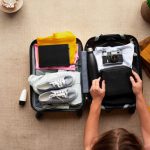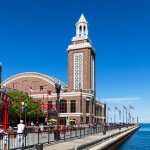Traveling in the United States can be an exciting adventure, but concerns about cost and safety can sometimes deter potential explorers. The good news is that you don’t need to spend a fortune or compromise your safety to have a memorable trip. With the right strategies, you can travel safely and affordably across the U.S. Here’s how to do it.
1. Plan Ahead to Avoid Surprises
Preparation is key to both saving money and staying safe. Before your trip, take time to research:
- Destinations: Know the safest neighborhoods, transportation options, and local customs.
- Accommodation: Book in advance to secure the best rates and avoid staying in unsafe areas.
- Weather: Check the forecast and pack accordingly to avoid unexpected costs for clothing or gear.
Additionally, use tools like Google Maps to familiarize yourself with your destination and plan your routes in advance.
2. Choose Budget-Friendly and Safe Accommodation
Your choice of accommodation can greatly impact your budget and safety. Consider these options:
- Hostels: Many hostels cater to budget travelers and have safety features like lockers and secure entry systems.
- Vacation Rentals: Platforms like Airbnb and Vrbo allow you to vet hosts and read reviews to ensure safety.
- Budget Hotels: Chains like Motel 6 or Super 8 often offer affordable rates and are located near major highways and attractions.
When booking, prioritize accommodations with high ratings and detailed reviews that mention cleanliness and safety.
3. Use Public Transportation Wisely
Public transportation can save you a lot of money compared to car rentals or ride-sharing apps, but it’s important to stay safe:
- Research Transit Systems: Learn about local bus, subway, or train options before you arrive. Most cities have apps or websites that provide schedules and safety tips.
- Avoid Late-Night Rides: Use public transit during daylight hours whenever possible.
- Keep Valuables Secure: Carry a crossbody bag or money belt to protect your belongings from pickpockets.
4. Travel During Off-Peak Seasons
Traveling during the off-season is one of the best ways to save money while avoiding crowds. For example:
- Visit popular summer destinations like national parks in early spring or late fall.
- Explore cities like New York or Chicago in the winter, when accommodations are often cheaper.
Off-season travel not only saves money but also reduces the stress of navigating busy tourist areas.
5. Pack Light and Smart
Packing efficiently can save you from baggage fees and help you stay prepared:
- Essentials: Include a first-aid kit, reusable water bottle, and portable charger.
- Clothing: Pack layers to adapt to varying weather conditions.
- Snacks: Bring non-perishable snacks like granola bars or trail mix to avoid overpriced airport or roadside food.
By packing light, you’ll have less to worry about and may even avoid the cost of checked luggage on flights.
6. Stay Connected
Having reliable communication is essential for safety:
- Cell Phone Plans: Consider prepaid plans like Mint Mobile or T-Mobile’s prepaid options to stay connected without breaking the bank.
- Wi-Fi Hotspots: Use free Wi-Fi at coffee shops, libraries, or accommodations, but avoid accessing sensitive information on public networks.
- Emergency Contacts: Share your itinerary with trusted friends or family and check in regularly.
Apps like WhatsApp or Skype are great for keeping in touch while traveling.
7. Save on Food While Staying Safe
Eating out can be expensive, but there are ways to save while enjoying local cuisine:
- Grocery Stores: Buy groceries and prepare simple meals, especially for breakfast and lunch.
- Local Markets: Explore farmers’ markets for affordable, fresh food and unique local flavors.
- Meal Deals: Many restaurants offer lunch specials or happy hour discounts.
Stick to reputable establishments with good reviews to avoid food-related illnesses.
8. Choose Budget-Friendly Activities
You don’t need to spend a fortune to enjoy the best of what the U.S. has to offer. Consider these affordable activities:
- National Parks: An America the Beautiful Pass costs $80 per year and grants access to over 2,000 federal recreation sites.
- Free Attractions: Many cities have free museums, public art installations, and historic landmarks.
- Walking Tours: Apps like GPSmyCity offer affordable self-guided tours for major cities and attractions.
By prioritizing low-cost activities, you can have enriching experiences without exceeding your budget.
9. Be Aware of Scams and Fraud
Protect yourself from scams that often target tourists:
- Overcharging: Verify prices for taxis, souvenirs, or meals before making purchases.
- Fake Tickets: Purchase tickets for attractions only from official websites or authorized vendors.
- Phishing: Avoid sharing personal information with strangers or unverified entities.
Stay vigilant and trust your instincts if something feels off.
10. Get Travel Insurance
Investing in travel insurance is a smart way to protect yourself from unexpected expenses:
- Medical Emergencies: Ensure your policy covers medical treatment and emergency evacuation.
- Trip Cancellations: Protect yourself from losing money due to unexpected cancellations.
- Lost Belongings: Coverage for lost or stolen items can save you from significant financial loss.
While it may seem like an extra expense, travel insurance can save you money in the long run.
11. Use Technology to Your Advantage
Smartphone apps can help you travel safely and save money:
- Navigation: Apps like Google Maps or Waze can help you find the safest and fastest routes.
- Budget Tracking: Use apps like Trail Wallet or Mint to keep track of expenses.
- Language Translation: If you’re visiting areas where English isn’t the primary language, apps like Google Translate can be invaluable.
Many of these tools are free and easy to use, making your trip smoother and more efficient.
12. Travel with Companions When Possible
Traveling with friends or family can enhance safety and reduce costs:
- Group Discounts: Many attractions, transportation options, and accommodations offer discounts for groups.
- Shared Expenses: Split costs for lodging, food, and gas to save money.
- Safety in Numbers: Traveling with others can deter potential threats and provide support in emergencies.
If you’re traveling solo, consider joining group tours or connecting with fellow travelers through platforms like Meetup.
13. Trust Local Authorities and Resources
In case of emergencies or safety concerns, don’t hesitate to seek help:
- Visitor Centers: Staff can provide reliable information on safe activities and areas to avoid.
- Emergency Numbers: Dial 911 for police, fire, or medical emergencies in the U.S.
- Consulates: If you’re an international traveler, know the location of your nearest embassy or consulate.
Being proactive can make all the difference in ensuring your safety.
Sample Budget-Friendly Itinerary
Here’s a 5-day travel plan to explore the U.S. safely on a budget:
- Day 1: Arrive in Washington, D.C., and visit free Smithsonian Museums and monuments.
- Day 2: Travel to Philadelphia to explore Independence Hall and the Liberty Bell.
- Day 3: Head to New York City for budget-friendly activities like walking the High Line and visiting Central Park.
- Day 4: Drive to Boston to walk the Freedom Trail and enjoy local seafood at a reasonable price.
- Day 5: End your trip in Salem, Massachusetts, exploring historic sites and affordable museums.
This itinerary combines safety, affordability, and cultural richness










